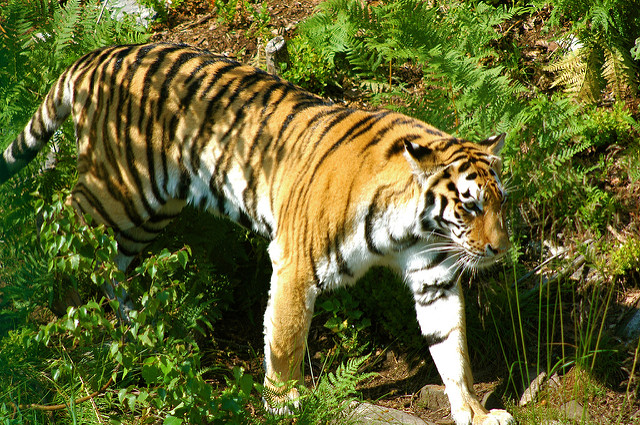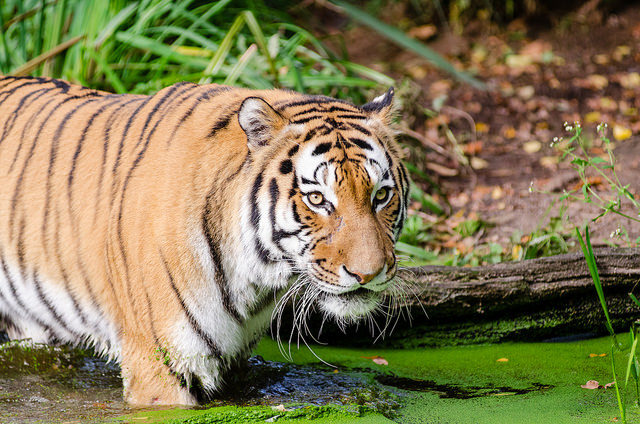
When wildlife department officers discovered 60 frozen and bottled tiger cub carcasses, pelts and a cache of other endangered species parts and products at Thailand’s famous Tiger Temple tourist attraction, the whole world was both shocked and outraged.
However, while the Tiger Temple discovery is deeply disturbing, it is believed that this particular case is merely the tip of a much larger iceberg. In the past decade, illegal wildlife trafficking and breeding has become a fast-growing and lucrative industry.
Tiger temple exposes the billion dollar trade for tigerparts in Asia https://t.co/jaJTTgskR4
— WAR-International. (@WildlifeAtRisk) 17 June 2016
Today, it is estimated that there are around 3,200 Tigers left in the wild – in 1900, the population had stood at around 100,000. Despite their dwindling numbers, tigers – and many other endangered species – are being hunted and farmed, in order to fulfill the demand for luxury animal products and traditional Chinese medicines.
“This is most evident with the use of rhino horn and tiger parts. This is part of a shift from traditional culture-related consumption to conspicuous consumption, which is also affecting many other species pressured by illegal trade,” said John Scanlon, secretary-general of the Convention on International Trade in Endangered Species of Wild Fauna and Flora (Cites), the world regulator of trade in protected wildlife.

More than 5,000 tigers are being farmed in China, 1,450 in Thailand, 180 in Vietnam and possibly 400 in Laos, according to research by the Environmental Investigation Agency (EIA), Australia’s Conservation and Environmental Education 4 Life (Cee4life), and others.
However, to make matters worse, many of the tiger farmers within the industry are masquerading as conservationists. As a result, it is likely many tourists are funding this dark and deadly trade while under the illusion that they are actually helping the animals’ fight for survival.
“These places are stockpiling dead parts in freezers. This [raid in Thailand] was just the tip of a trade that spans south-east Asia and sees so-called tiger sanctuaries and farms secretly selling tiger parts and products on the black market for enormous profit,” said Debbie Banks of the EIA.
In 2007, an international agreement was made, stipulating that tigers should not be bred or farmed for trade in parts. However, since the agreement was reached, the demand for tiger parts has only increased, and the trade in body parts from captive tigers has rapidly risen.
More controversy surrounding the Tiger Temple: https://t.co/pI6F7awuy5
— National Geographic (@NatGeo) 14 June 2016
“Many of the hundreds of tiger part seizures in Asia appear to be from captive-bred animals, and Traffic has previously called upon a number of countries, including Thailand, to demonstrate what controls are in place to prevent such illegal trade taking place,” said spokesman Richard Thomas.
More than 50% of seizures of tiger farms over the past 14 years have occurred since 2010, the Guardian reports. It is believed many of these animals were captured in the wild. Corrupt authorities and powerful business men are widely suspected of pillaring and supporting the trade of tiger parts.
“China has systematically exercised internal trading privileges for companies dealing in skins and derivatives, produced mainly but not exclusively from captive breeding,” say a 2014 report commissioned for Cites.

Due to the increasing demand for tiger parts, traffickers are using porous borders between Thailand, Myanmar, Laos and China to easily transport the products for their own financial gain. As reported by the Guardian, just last month, “a 26-year-old Vietnamese man was found with four frozen tiger cubs at the Laos border. He said he had bought the carcasses at a border market for 2 million Vietnamese Dong (£62) and was delivering them to a buyer.”
While many have argued that captive breeding of an endangered species will help ensure the species survival, World Wide Fund for Nature (WWF) believes the practice merely fuels the demand for tiger parts. Today, there are around 50 wild tigers left in China; however, in comparison, “two large tiger farms and many smaller ones legally hold some 5,000 animals.”
“We don’t want to see tigers commercialised in any way,” said Colman O’Criodain, WWF’s wildlife trade specialist. “The fact is, the wilder the tiger, the better the medicine is considered. It’s also very expensive to rear tigers in captivity. With the difficulty of separating farmed products from wild ones, it’s too much of a risk. There is too much temptation to cash in.”
Banks added: “Tiger farms have nothing to do with conservation of wild tigers. On the contrary, both legal and illegal trade in parts and products from these horrific facilities are stimulating demand, which drives the poaching and extinction of wild tigers.”
Although it is hoped that the recent Tiger Temple discovery will raise the public’s awareness and will prompt many to take action against the farming and trafficking of tigers, only time will tell if the world is ready to wake up to the harsh reality of this horrific industry.
The next ‘Blackfish’ controversy may be at Thailand’s Tiger Temple https://t.co/RmJvMtn9ANpic.twitter.com/GsclZysEPn
— Big Cat Rescue (@BigCatRescue) 11 June 2016
Image: Flickr, Mathias Appel
You want to support Anonymous Independent & Investigative News? Please, follow us on Twitter: Follow @AnonymousNewsHQ
This article (Tip of the Iceberg: Thailand’s Tiger Temple Reveals a Much Larger Wildlife Farming and Trafficking Industry) is a free and open source. You have permission to republish this article under a Creative Commons license with attribution to the author and AnonHQ.com.




